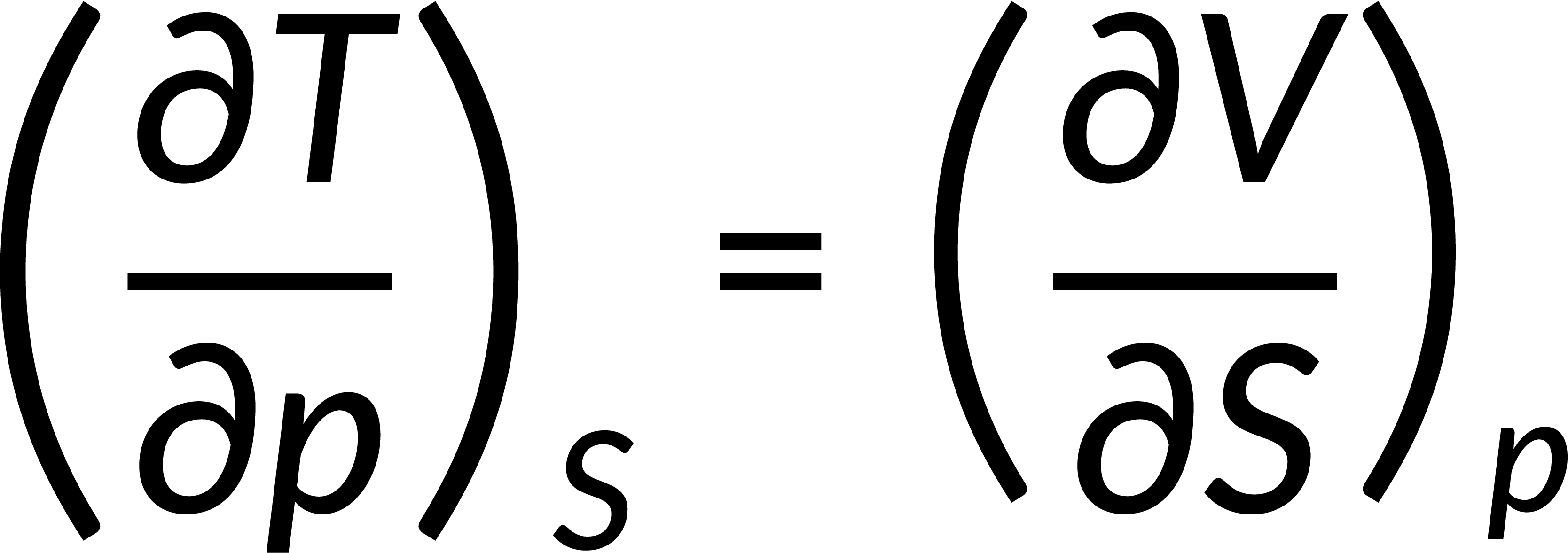20.18 : Relações Termodinâmicas de Maxwell
Maxwell's thermodynamic relations are very useful in solving problems in thermodynamics. Each of Maxwell's relations relates a partial differential between quantities that can be hard to measure experimentally to a partial differential between quantities that can be easily measured. These relations are a set of equations derivable from the symmetry of the second derivatives and the thermodynamic potentials.
All thermodynamic potentials are exact differentials. Therefore, their second-order derivative does not depend on the order of differentiation. In the case of Maxwell's relations, the thermodynamic potential is expressed in terms of the partial derivatives of that function. Substituting the values of the partial derivatives gives Maxwell's equations. The four Maxwell's relations are:




These equations relate entropy changes, which are difficult to measure, with changes in other thermodynamic variables, like temperature, volume, and pressure, that are easier to measure. For example, in the last equation, the left-hand side term gives the change in pressure with the temperature at constant volume. This quantity can be easily measured in a laboratory. However, the term on the right-hand side of the equation is more complicated, as it is hard to measure the entropy change with volume at a constant temperature.
Do Capítulo 20:

Now Playing
20.18 : Relações Termodinâmicas de Maxwell
A Primeira Lei da Termodinâmica
2.4K Visualizações

20.1 : Sistemas Termodinâmicos
A Primeira Lei da Termodinâmica
4.9K Visualizações

20.2 : Trabalho Realizado Durante a Mudança de Volume
A Primeira Lei da Termodinâmica
3.8K Visualizações

20.3 : Caminho Entre os Estados Termodinâmicos
A Primeira Lei da Termodinâmica
3.0K Visualizações

20.4 : Calor e Expansão Livre
A Primeira Lei da Termodinâmica
1.7K Visualizações

20.5 : Energia Interna
A Primeira Lei da Termodinâmica
4.3K Visualizações

20.6 : Primeira Lei da Termodinâmica
A Primeira Lei da Termodinâmica
4.0K Visualizações

20.7 : Primeira Lei da Termodinâmica: Resolução de Problemas
A Primeira Lei da Termodinâmica
2.4K Visualizações

20.8 : Processos Cíclicos e Sistemas Isolados
A Primeira Lei da Termodinâmica
2.7K Visualizações

20.9 : Processos Isotérmicos
A Primeira Lei da Termodinâmica
3.5K Visualizações

20.10 : Processos Isocóricos e Isobáricos
A Primeira Lei da Termodinâmica
3.3K Visualizações

20.11 : Capacidades Caloríficas de um Gás Ideal I
A Primeira Lei da Termodinâmica
2.5K Visualizações

20.12 : Capacidades Caloríficas de um Gás Ideal II
A Primeira Lei da Termodinâmica
2.3K Visualizações

20.13 : Capacidades Caloríficas de um Gás Ideal III
A Primeira Lei da Termodinâmica
2.1K Visualizações

20.14 : Processos Adiabáticos para um Gás Ideal
A Primeira Lei da Termodinâmica
3.0K Visualizações
See More
Copyright © 2025 MyJoVE Corporation. Todos os direitos reservados